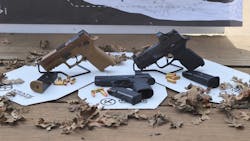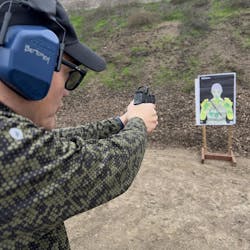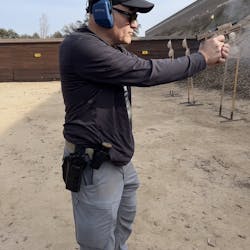Modifying Your Duty Gun
Recently, I was shooting a box-stock Sig Sauer M18 (P320 variant), which I had borrowed from Sig Sauer. My friend broke out his highly customized P320 and we began comparing them side-by-side. Would you customize your duty gun? Would your motivation be aesthetics, or would there be a specific purpose to your modifications? As a police armorer, I have inspected dozens of guns, and reviewed many modifications. This article is a discussion about some of the more common modifications.
Many agencies have policies precluding modification. Some agencies restrict even adding grip tape, or sights to their firearms. Others allow modifications, provided they are overseen by an armor or gunsmith. Some agencies have agency-wide modifications to their firearms. For example, one of the local agencies in my area is converting to optics.
If every gun fit every assignment and every user, it would be a much simpler world, and I’d be out of a job. At the very least, it may be a good idea to break out the policy on modification of firearms and review it to ensure it meets the needs of your department.
Adding lights
The number of dedicated lights available for Law Enforcement has increased geometrically. The quality has continued to rise as well. For example, Streamlight’s TLR 7A Tactical Weapon Light fires 500 lumens from a single CR123A battery and uses paddle switches. This new switch system is more intuitive and aids in the compactness of the torch.
One thing an Officer must consider is the choice of using a dedicated light may influence the holster preference. For example, some holster makers have a Level III holster without a dedicated light and only a Level I for mounted guns. Others only offer holsters in certain styles.
Having said that, several major manufacturers make Level 3 light-bearing holsters. For example, Blackhawk has Level 3 holsters in their T-Series. They use a thumb-activated retention. I tested one, and it really lets the Officer attain the Master Grip well.
I have used a Safariland 6365 ALS/SLS Series holster, which are also have Level III retention. Safariland Holsters can be ordered in specific configurations, for specific retention levels, ride, and dedicated lights. Safariland’s latest, the SafariVault, is even more robust, and the open bottom, and reinforced body, make it the top of the line for duty wear.
Finally, it is no secret that I like Gould and Goodrich’s T.E.L.R. Holsters, with their thumb-activated hood. The X4000 model is the light-bearing version. Like most holsters of this design, they accommodate a variety of lights, and provide a quiet and secure platform.
I found the characteristic of the draw changes with the addition of a light in any holster line. I thought this was just because of my aversion to dedicated lights, but the shot timer does not lie. Using a dedicated light on a duty gun is priceless, but it requires dedicated training.
Grip improvement
I’m never completely satisfied with the stock grip on my carry guns. I have learned to stipple rather well, so there’s that.
Most people believe that stippling is expensive and complicated, but it’s really quite simple. I use a Creative Versa-Tool iron from Hobby Lobby, which is like a soldering iron with more precise adjustment. It comes with several stippling tips, from ones that look like a needle, to others that can create checkerboards. The tool costs less than $30, and I also use it as a soldering iron for my old radios.
If you wish to begin stippling, find a scrap piece of plastic for practice. Several of my old gun boxes have practice areas stippled on the side.
Does stippling work, or is it just an aesthetic thing? Actually, it works amazingly well. I use stippling to increase the speed at which I index my draw. That is, my gun has a certain feel when I grip it correctly. I created more textured areas in order to enhance this feel. Because I can orient myself faster, the draw is faster. It may only make a .01 second difference, but I will allow the reader to measure the consequences of an improved draw here.
I also use Handleitgrip decals for several other guns. This is a decal grip improvement that comes in textured rubber or sand paper. These grips are adhesive, but they require heat to ensure full adhesion. I find the decal grips last a couple of years, under heavy use. I recommend that you “re-grip” your duty gun every year or so, or any time it shows signs of wear.
The rubber decal grips from Handleitgrips are significantly better than any stock gun grip. They work when wet, and stay on when the duty gun goes to IWB, constantly against the body.
RDS (Red Dot Sights)
Everyone is running optical sights now, so I won’t spend a lot of time discussing them. There have been a lot of products flooding the market that are less expensive than the big names like Holosun, Aimpoint, and SIG. The cheaper ones are perfectly good for an afternoon at the range. I would not put off-brand sights on duty. You are paying for durability and good optics.
Most people know I am hard on equipment and run a Holosun 509. If the product survives my clumsiness…
Optics use requires training that needs to reflect their investment. That is, you are now using two types of aiming systems (RDS and iron), that are independent of one another. This means twice as much training time investment for the system.
I use the One and One Drill (https://www.officer.com/tactical/firearms/article/21128477/three-firearm-training-drills-made-easy-let-firearms-tactics-april-may-2020) to train using RDS optics. When using optics, the paradigm is completely different. With iron sights, the shooter generally trains to find the front sight and align it to the target, thus completing the sight picture from sight alignment. With the red dot sight, the shooter establishes target focus, then brings the sight into the sighting plane.
Trigger
The two most common aftermarket modifications on a trigger are the trigger face, and trigger performance. For the trigger face, many shooters prefer a flatter trigger than the traditional curved ones. Although also aesthetically pleasing, a flat trigger allows the shooter to position the finger further from the fulcrum. The curved trigger allows the finger to rest on the deepest part of the curve, the flat one gives more latitude.
Further from the fulcrum means more leverage. More leverage means a lighter pull.
The most common trigger performance available is a trigger weight reduction. The first thing we need to know is that reducing trigger weight will not improve the accuracy of the shooter. That is, investing in training time is wiser than attempting to change the characteristics of the trigger. Weight reduction usually means reducing the spring system or release system of the trigger, depending on the design of the gun. In some designs, this means a lightened trigger can translate into reduced reliability. It’s not worth it.
Drop-in trigger enhancements are different. Several manufacturers have designed reliable, duty-worthy, trigger systems that improve the efficiency of the trigger, not necessarily the weight. One of the best products out there is from Apex (Apextactical.com), which is probably going into my M18 soon.
If you opt for a trigger kit, purchase the entire assembly, not just a single component. If your duty gun is a P320, consider getting a P320 FCU from their Custom Works department. It comes with a skeletonized trigger already tuned. In my Glock, I run a ZEV trigger kit, which improves the crispness, without compromising safety or reliability.
The conversation about triggers has to address many of the other internal parts that a person would change under the hood. For example, some people elect to use a striker made of different materials or alloys. Usually the goal is to make them lighter, so there are plenty of titanium strikers on the market today. It’s not unreasonable to change these things for a competition gun, but swapping out any type of internals, including plunger springs, rebound springs, and extractor components can be risky.
Extended Slide Release
Some officers want to have extended slide releases on their duty guns because they saw one on someone’s race gun or something like that. They work, but they could actually get in the way, or worse, impact the holster draw. This type of accessory is not recommended.
Magazines
Here’s a rule: If you ever have a reliability issue with your firearm, the first place to look is your magazine. It’s not always the solution to a failure to operate, but, statistically, magazine failure is often the culprit. Eliminating magazine failure: It is time to Occam’s Razor your gun.
If you wish to ensure reliability on duty, use a 1:4 ratio. You should have training magazines and duty magazines. The training magazines can be the ones you drop on the range during realistic sessions. They should get banged around and worked over, if your training is worthwhile. Every 4 times you train, use your duty magazines. This will ensure that your duty magazines get rotated. Continuing with ratios, shoot your duty ammo at least once a year, and restock your duty gun with fresh ammo.
One thing you should know about magazines is that they are generally contracted out to companies that specifically make magazines. I was talking to Brandon Vitulli of Check-Mate Industries at SHOT Show one year and told him I had never heard of Check-Mate Industries. He told me they make magazines, and I was probably using their products already. I found out later I was.
When I run a single-stack 1911 handgun, I use Metalform Magazines, with a smooth finish like Teflon or black nitride. Otherwise, I buy magazines directly from the manufacturer.
The truth is, gun companies like Sig Sauer and Springfield Armory already use the best quality magazines that money can buy. If you have a magazine failure from these guys, it likely just needs new components (follower, spring, base plate), or it is dirty. If the feed lips are bad, the injury will likely be visible. For duty guns, it is smart to replace the components when they look worn, and the springs once a year. If they are training magazines, you should know that springs last much longer, so rotate your duty springs into the training stack.
Sights
Employing optics, or other accessories like suppressors, require taller sights. Not only do they allow the user to co-witness inside of the glass of the optic, larger sights are easier for the brain to orient. The bonus is the fact that suppressor height sights hook easier on things, making them ideal for one-handed shooting.
Sight manufacturers have stepped it up when it comes to ensuring the taller sights are as strong as the short ones. I would bet my shooting on the Trijicon Suppressor/Optic Height Sights every time.
Slides
If you are considering replacing the slide in your gun, ask yourself the underlying reason. For example, it is certainly reasonable to go from a non-optic slide to one that will accept an optic. Some slides have lightening cuts that shift the weight of the slide more towards the hand. This changes the handling characteristic, and sometimes allows them to shoot faster. However, if your consideration is one of aesthetics, stick with the stock equipment.
I wouldn’t think twice about changing a stock P320 slide with a pro cut one. It didn’t change much as far as engagement timing (measured on my Range Tech Shot Timer), but it felt better in the hand. And yes, it looks better.
Before swapping slides, I would ensure that the product fit the holster 100%. This is less of a problem these days with holster products using ejector port locking devices.
Finally, it is much better to invest in training then modifications to the firearm. A well-trained shooter with a stock gun will always have an advantage over a poorly trained shooter with a very expensive gun.
About the Author
Lindsey Bertomen is a retired police officer and retired military small arms trainer. He teaches criminal justice at Hartnell College in Salinas, California, where serves as a POST administrator and firearms instructor. He also teaches civilian firearms classes, enjoys fly fishing, martial arts, and mountain biking. His articles have appeared in print and online for over two decades.
About the Author

Officer Lindsey Bertomen (ret.), Contributing Editor
Lindsey Bertomen is a retired police officer and retired military small arms trainer. He teaches criminal justice at Hartnell College in Salinas, California, where serves as a POST administrator and firearms instructor. He also teaches civilian firearms classes, enjoys fly fishing, martial arts, and mountain biking. His articles have appeared in print and online for over two decades.


